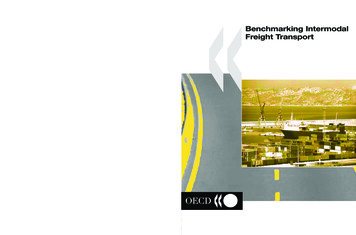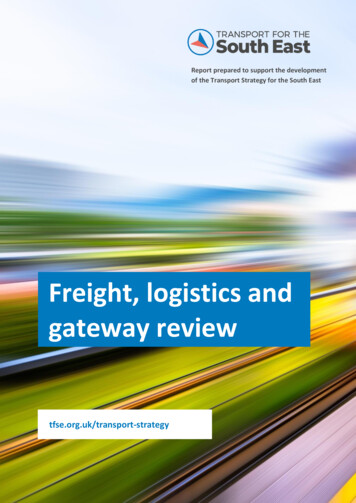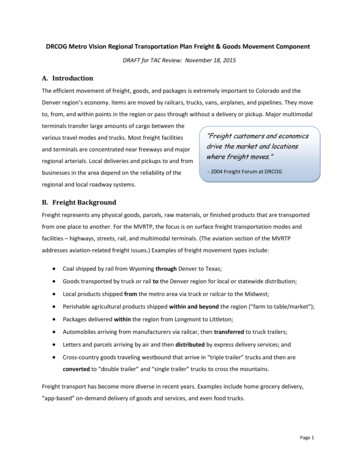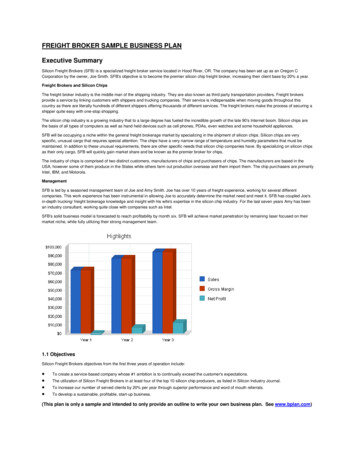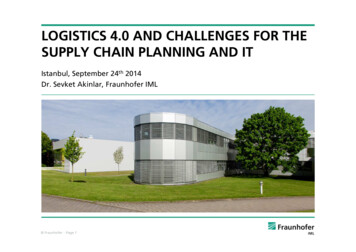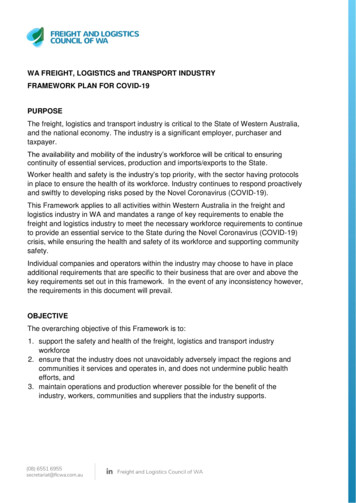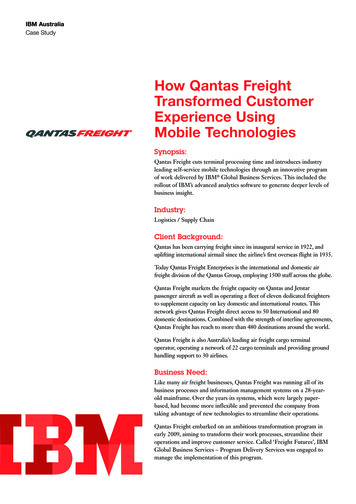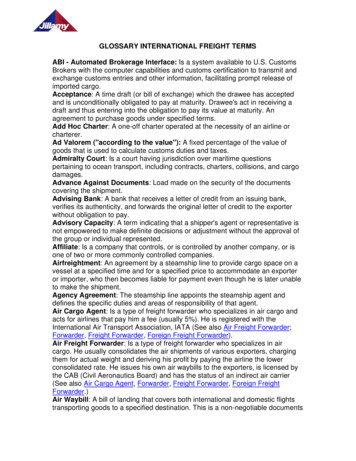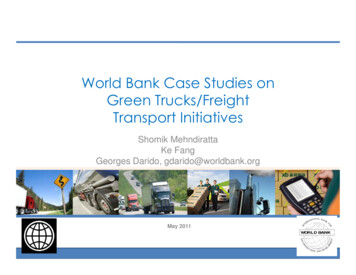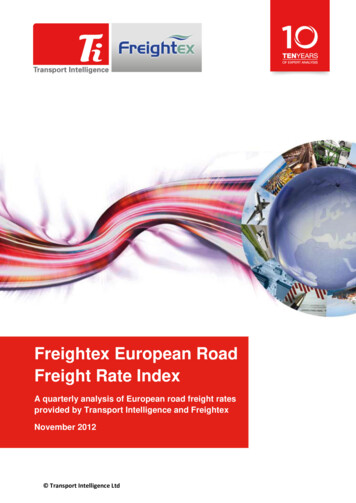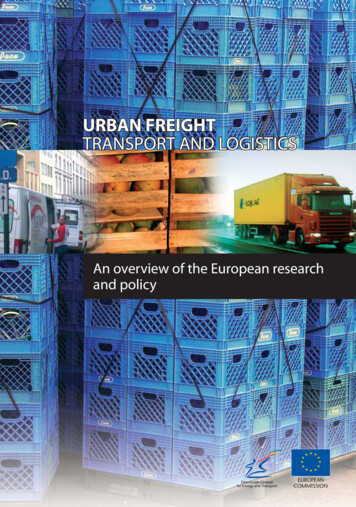
Transcription
URBAN FREIGHTTRANSPORT AND LOGISTICSAn overview of the European researchand policyEUROPEANCOMMISSION
CONTENTSFOREWORD11 DEFINITION OF THE SUBJECT22 RESEARCH NEEDS33 RESEARCH PROGRAMMES54 RESEARCH RESULTS75 EUROPEAN POLICY IMPLICATIONS136 FUTURE RESEARCH DEVELOPMENTS157 REFERENCES17This publication was produced by the EXTR@Web consortium on behalf ofDG Energy and Transport. The information in this document has been collected bypartners in the project on the basis of material provided by DG TREN and projectpartners.We would like to thank Professor Michael Browne and Dr Julian Allen from theUniversity of Westminster, UK for contributing to the review of the manuscript.While the information contained in this brochure is correct to the best of ourknowledge, neither the consortium nor the European Commission can be heldresponsible for any inaccuracy, or accept responsibility for any use made thereof.Additional information on transport research programmes and related projects isavailable on the Transport Research Knowledge Centre website on the EuropeanCommission’s Europa server:http://ec.europa.eu./transport/extraIn addition, a public e-mail enquiry service is available at:helpdesk@transport-research.infoInformation on the wider transport activities of the European Union is available onthe internet. It can be accessed through the Europa server:http://ec.europa.eu./dgs/energy transport/index en.htmlManuscript completed by Damian Stantchev and Tony Whiteing, ITS (University ofLeeds), in July 2006. European Communities, 2006Photos: courtesy of DHL (p.4) and iStock.com (p.16)Reproduction is authorised provided the source is acknowledged.Printed in Belgium
URBAN FREIGHT TRANSPORT AND LOGISTICSFOREWORDThis document provides an overview ofresearch results from the EC’s Fourth andFifth Framework programmes and a series ofnational research projects in the area of urbanfreight transport and logistics. It also discussespolicy implications and requirements for futureresearch.The adoption of best practice methods offersthe most promising opportunities for urbanlogistics operations to become both moreefficient and more environmentally sustainable.Such best practice methods include: the use of more environmentally-friendlyalternatives to current urban freighttransport practices through improvedfuel efficiency and the use of alternativefuel vehicles; the use of information and communicationtechnologies (such as RFID and vehiclerouting software); the possibility to improve deliveries to urbanareas through the use of urban distributionnetworks and consolidation depots.Full benefits are unlikely to be achieved,however, when such proposals are put intopractice in isolation, and it may well be moresensible to consider them as a wider packageof measures. This topic has therefore beenexplored in the light of the need for integratedsolutions, which pull the above-mentionedpolicy measures together and help eliminatethe obstacles to achieving more effectiveand sustainable urban freight transport andlogistics practices. Roles and responsibilities ofthe various actors and stakeholders have alsobeen considered as an additional element ofanalysis.1
1DEFINITION OF THE SUBJECTUrban freight transport and logisticsoperations are concerned with the activities ofdelivering and collecting goods in town andcity centres. These activities are often referredto as ‘city logistics’ as they entail the processesof transportation, handling and storage ofgoods, the management of inventory, wasteand returns as well as home delivery services.Often many of these processes, or parts ofthem, are undertaken outside urban areas butthey still have impacts on urban operations.Therefore, freight transport and logisticsoperations in urban areas cannot be viewedand studied in isolation but rather in thecontext of the entirety of supply chains thattypically cross the geographical boundaries ofurban areas.The growing significance of urban freighttransport and logistics is related to increasedpopulation and sustained economic growthin urban areas. Goods transport in citiesrepresents from 10 to 18% of road traffic(COST321, 1998). As the majority of thepopulation in Europe lives in urban areas andthe bulk of industrial production is despatchedto these areas, the result is an increaseddemand for freight transport. Furthermore, asurban freight transport deals primarily with thedistribution of goods at the end of the supplychain, many deliveries tend to be made in smallloads and in frequent trips, thus resulting inmany vehicle kilometres.The urban environment is characterised byhigh settlement and population densities andhigh consumption of goods and services. Insuch environments traffic infrastructure andthe possibilities for its extension are bothlimited and unsustainable. This dichotomybetween demand and limitations of theurban environment has resulted in significantproblems associated with urban freighttransport. The most commonly mentioned arecongestion, pollution, safety, noise and carboncreation. In fact, the transportation of goodsaccounts for 40% of air pollution and noiseemissions (COST321, 1998). The combinedeffects of these problems are both economicand societal, in that they not only reduce theefficiency and effectiveness of urban freighttransport and logistics operations but alsoimpact on the well-being of a nation bydecreasing the quality of life of citizens andthrough detrimental effects on health.One would expect that, because of itsimportance, this topic would have been given amore central role in European policy making.However, despite its significance and theproblems associated with it, relatively littleattention has been paid by researchers andpolicy makers until recently. Indeed, especiallyin the first half of the 1990s, “in the documentsthat the Commission has published to supportthe making of a common European transportpolicy, issues of city logistics have in fact beenonly rarely mentioned” (PORTAL, 2003, p.7).European policy documents concentratingspecifically on urban freight transport andlogistics remain relatively rare.
URBAN FREIGHT TRANSPORT AND LOGISTICS2RESEARCH NEEDSImprovements to the urbanenvironment through themore environmentally friendlyuse of freight transportvehiclesThere is a need to identify the most suitabletypes of vehicles for urban freight and logisticsoperations. Key areas for consideration relateto the most appropriate size of vehicles to beused and the type of fuel they require. Manyissues such as pollution, carbon creation, noiseand safety must all be considered. There is aproblematic trade-off between the size andcapacity of the vehicles and the numbers ofvehicles that will be required to fulfil logisticalneeds. The type of fuel is important not onlyfor fuel consumption and hence emissions ofpollutants and greenhouse gases but also, fromthe point of view of noise although, of course,urban noise levels are affected by the handlingsystems used as well as by the operation of theengine. There is a need for research into howthe use of environmentally friendly vehicletechnologies can be encouraged or enforced.What restrictions should be applied to urbanvehicle movements according to vehicletype and size? Should financial penalties orincentives be used to influence the choicesmade by vehicle operators? Should nighttime deliveries be encouraged to reducecongestion impacts and, if so, how can potentialnoise problems be ameliorated?Improved deliveries to urbanareas through the use of urbandistribution networks andconsolidation depotsPerhaps the greatest potential for environmentalimprovement in urban logistics relates to theimproved consolidation of the many small loadsprior to delivery into the urban centre. What,then, constitute the best opportunities for therationalisation of urban logistics operationsthrough the use of consolidation depots, andwhat are the limitations on their use? Whyhas this seemingly attractive idea seen solittle success in practice to date? Who shouldoperate such facilities, and should their use bemandatory or voluntary? What areas should theyserve? Is there potential to link the operationof such schemes to transport modes otherthan the lorry, for instance by locating urban23
consolidation depots at, or close to, rail andintermodal terminals or, as has been suggestedin some cities, by using urban tram and light railnetworks for freight operations?a need for research to identify how they canbe used to best advantage to improve theenvironmental performance of urban logisticsoperations.The use of information andcommunication technologies(such as RFID, vehicle routingsoftware or load sharingsystems)The need to consider theseproposals as a wider packageof measuresThe logistics industry has already embraced awide range of information and communicationtechnologies and reaped major efficiency gainsas a result. This is almost certainly the areawith the greatest ‘win-win’ potential, i.e. whereefficiency gains go hand in hand withenvironmental benefitthrough reducedtravel distances,fewer vehicleThere are many other issues which couldbe taken into consideration to improve theperformance of urban logistics operations, suchas driver behaviour and training, the role of thereceiver/customer in improving thesustainability of urban freight, and the scopefor improved policymeasures and enforcement(both in terms of road freight and otherroad users for moving and parked traffic). In thisbrochure, however, attention is focused on thethree areas outlined above.movements, better matching of vehicles to workand improved levels of load consolidation.In the future, Intelligent Transport Systemswill introduce many opportunities for bettermanagement and control of urban logisticsoperations, for instance through the use ofdynamic scheduling systems linked toreal-time traffic and road works information.As the pace of development of suchtechnologies continues to increase, there isThese may produce significant environmentalbenefits when introduced in isolation,although all towns and cities are different andthe potential benefits will vary from place toplace. However, the potential benefits may beconsiderably magnified if all the possibilitiescan be combined to produce the most effectiveoverall package of measures for the area inquestion. This important aspect of the problem isdiscussed further in Section 5.
URBAN FREIGHT TRANSPORT AND LOGISTICS3RESEARCH PROGRAMMESThe European CommissionThe following EU programmes and subprogrammes have funded research projectsin the area of urban freight transport andlogistics: FP4 - Strategies for changing modal split(including transport means, organisationand operation) – projects such as UTOPIA FP4 - Transition in multi-modal transport– projects such as REFORM FP4 – Quality of the terminals – projects suchas FV-2000projects within the CIVITAS II Initiativesuch as CARAVEL, MOBILIS, SMILE andSUCCESSThe BESTUFS network is a notable example ofresearch in this area. Its aim was to “establishand maintain an open European networkbetween urban freight transport experts, usergroups/associations, ongoing projects, interestedcities, the relevant European CommissionDirectorates and representatives of national,regional and local transport administrationsin order to identify, describe and disseminatebest practices, success criteria and bottleneckswith respect to the movement of goods in urbanareas.” (Huschebeck, 2004, p.3). Following itssuccess, the BESTUFS II project was launchedin 2004 under the EU FP6 programme. FP4 – “Transport RTD Programme”– projects such as IDIOMANational programmes FP5 – Growth, KA 2 “Sustainable Mobilityand Intermodality” – projects such asBESTUFS and D2D; Demonstrationprojects within the CIVITAS I Initiativesuch as VIVALDI, TELLUS and MIRACLES FP5 – EESD, KA 4 “The City of Tomorrowand Cultural Heritage” – projects such asCITY FREIGHTThe following are examples of nationalresearch programmes across Europe. Many ofthese programmes, however, deal primarilywith public transport rather than freightand only individual projects within theseprogrammes focus directly on the area ofurban freight transport and logistics: Logistics Austria Plus (Austria, 1999-2003) FP5 – IST, KA 1 “Systems and Services for theCitizen” (KA 1, Cluster 1 “Mobility andIntelligent Infrastructure for Transport”)– projects such as GIFTS, MOSCA andeDRUL FP5 – EESD, KA 6 “Economic andEfficient Energy for a Competitive Europe”– TRENDSETTER (a CIVITAS project) Mobility and Transport (Germany, ongoing):Optimised Transport Logistics for Recyclingand Waste Management sub-programme Flexible Transport Chain (Germany, 19972001) Centre for Logistics and Freight Transport(Denmark, 2001-2005) FP6 – “Sustainable Development, GlobalChange and Ecosystems” thematic area 45
Ministry of Transport and Communication’sR&D Projects Supporting Transport Policy(Finland, ongoing): projects within the ‘GoodsTransport and Logistics’, ‘Transport ofDangerous Goods’ and ‘Environment andVehicle Engineering’ themes. VALO Real-time Logistics in Networks(Finland, 2001-2004) VINNOVA SP8 Innovative Logistics andFreight Transport Systems (Sweden) Department for Transport (UK, ongoing),Freight Best Practice and Freight andLogistics Programmes. Examples ofprojects include ‘Alternative DeliverySolutions – Nottingham Trial’ and ‘UrbanConsolidation Centres’ (SustainableDistribution Research sub-programme); National Programme on Urban GoodsTransport (France, ongoing); FrenchMinistry of Transport, ADEME PIEK multi-annual programme intodelivery noise (The Netherlands)
URBAN FREIGHT TRANSPORT AND LOGISTICS4RESEARCH RESULTSImprovements to the urbanenvironment through themore environmentallyfriendly use of freighttransport vehiclesThe ‘Best Urban Freight Solutions’ (BESTUFS)European project has provided the followingrecommendations on how best to improvethe urban environment through the moreenvironmentally friendly use of freighttransport vehicles. The recommendationsaddress the following areas:Size of vehiclesThe BESTUFS project identified the needto use higher cubic capacity vans and morespecialist equipment (e.g. for the transportationof fragile and temperature sensitive goods).The use of more environmentallyfriendly vehicle technologiesThe BESTUFS project has highlighted theenvironmental and noise reduction benefitsof Compressed Natural Gas (CNG) and electricpropelled vehicles. The lack of a comprehensiveCNG supply infrastructure in Europe, however,has been identified as an obstacle to the morewidespread adoption of CNG vehicles. Theproject has also recommended an increase inthe share of alternative fuels and active supportfor the development of environmentallyfriendly vehicles for urban transport within thesubsequent Framework programmes. Otherareas for improvement outlined by the projectare largely concerned with enhancing thecurrent understanding of alternative enginesand fuels, which the project has recommendedto be undertaken by considering the US andinternational experience.The need for research into how theuse of environmentally friendlyvehicle technologies can beencouraged or enforcedThe BESTUFS project has provided an insightinto the instruments that are required topromote the use of environmentally friendlyvehicle technologies. The project suggesteda set of encouragement measures to supportthe use of innovative vehicle technologies,such as an exemption from access restrictionsto the inner city for low emission vehicles.Other promotional measures included thedemonstration of new vehicle technologies,especially in authority-owned and -operatedfleets.The summaries of projects on the next page(p.8) are examples of research projects, whichcomplement and expand the above-listedBESTUFS recommendations.67
The CITY FREIGHT project targeted the problems of road freight transport in urbanareas by providing guidance to a range of interested stakeholders on the best practicesfor analysing their city freight problems as well as for designing and implementingintegrated strategies to solve them. Such best practice recommendations include: reducing the noise emissions of off-peak deliveries; consolidation of consignments; combining freight traffic with passenger traffic within the cities to reduce thedemand for transport (e.g. through the use of Cargo Tram, electric and hybridelectric vehicles, bicycle couriers and distribution by walking); integrating land use and transport planning.Source: http://ec.europa.eu/transport/extraThe UTOPIA project aimed to provide project managers and policy-makers withthe necessary information base, tools and guidelines to support the introduction ofpromising urban transport solutions based on cleaner vehicles. UTOPIA developedfour major outputs: an assessment of the most promising applications for cleaner vehicles andsupporting measures, from a city perspective; recommendations on policy actions at the European and national levels to promoteor facilitate market introduction and demonstration; a good practice guide to setting up and running pilot and demonstration projects,aimed at potential project champions; a software framework (‘NAVIGATE UTOPIA’), which provides information andassessment methodologies covering clean transport solutions.Source: http://ec.europa.eu/transport/extraThe COST 321 project studied the design and implementation of innovative measuresto improve the environmental performance of freight transport in urban areas. It hasanalysed how “air pollution, noise and energy consumption are reduced by optimisingthe use of trucks in city traffic through the application of modern logistical devicesand appropriate administrative measures.” (PORTAL, 2003a, p.8) The project suggestedthat the optimisation of urban freight transport should take into account the followingparameters: transhipment technology land use management conditional access for delivery service providers transport fleet composition infrastructure capacity locally convened development forms and programmes political drive and availability of money.Source: http://www.eu-portal.net
URBAN FREIGHT TRANSPORT AND LOGISTICSSafety of urban freight transport and logisticspractices is another area which needsto be considered. An Irish study entitled‘Contributions to the Safety and Efficiencyof the Multi-drop or Local/Short HaulOperations’ identified a number of constraintsand incompatible requirements that wereimpacting on the safety and efficiency of theUrban Multi-Drop Delivery (UMDD) operations.Traffic levels, transport policy measures,ineffective regulation, customer demands,internal management and work processes wereidentified as constraints affecting the abilityof the UMDD service to function safely andefficiently (See: .The use of information andcommunication technologies(such as RFID, vehicle routingsoftware or load sharingsystems)Research into the use of information andcommunication technologies has called foractions towards standardisation (Huschebeck,2004). The BESTUFS project has recommended: To continue the standardisation activitiesrelated to traffic information datatechnology. Currently, traffic informationdata comes from different sources forwhich different content, formats andprotocols are in use. Therefore, acommon standard for alldata was found to be of potential benefit; To promote various ways of datacommunication (such as GPRS, UMTS,radio frequencies, etc) and not to favourone communication standard as this willallow finding cheaper solutions in thefuture; Most of the conclusions of previousresearch projects, such as COMETA,FLEETMAP, SURFF or INTACT, regardingstandardisation issues in freighttransport management systems weredeemed valid. The development of webbased technologies was pointed out as asource of future solutions. The need forflexible low cost technologies for urbanfreight transport standard data formatsfor transport planning systems was alsooutlined.The summaries of projects below and on thenext page (p.10) are examples of researchprojects that complement and expand theabove-listed BESTUFS recommendations.The GIFTS project explored the use of telematics for the management of deliveriesand the intensive use of automated and computerised methods for handling of freight.The outcome of the project was an open access Internet portal/e-marketplace providingservices to the logistics and freight transport industry in the European Union.The project has implemented a web platform of services that is fully interoperable andintegrated with any ICT system. GIFTS provides applications for the operational (e.g.tracking, tracing and monitoring of the door-to-door journey; aid in trip management;tracking and tracing of goods; fleet management, etc.), as well as all the e-commercefunctions and insurance of a door-to-door freight transport chain (i.e. including ordermatching, e-document transfer, e-payment, etc.).Source: http://ec.europa.eu/transport/extra89
The MOSCA project has developed a set of tools for improving the efficiency of doorto-door transport of goods in urban areas. This set of tools offers services for shortestpath finding, on-line vehicle routing planning and urban shop delivery planning.The MOSCA project has also addressed the issues of integration and interoperabilityat European level. To achieve integration and interoperability at European level,the project has called for the development of innovative tools and methods for themanagement of freight deliveries in city centres at a European rather than national orcompany level.Source: http://ec.europa.eu/transport/extraThe D2D project, whilst not particularly focused on urban freight and logistics, hasdemonstrated how to achieve efficiency within the transport chain with the assistanceof advanced information and communication technology. The main results of theproject comprise: a transport chain management system available as a web basedapplication on the Internet, a monitoring system, the efficient implementation of asystem integration tool (communication platform), simulation and service profilingtechnology and tracking and tracing technology. The D2D system reduces thecomplexity of organising the physical and information flows within the supply chainand contributes to improved quality of life, health and safety of citizens by reducingpollution and noise and relieving congestion.Source: http://ec.europa.eu/transport/extraThe eDRUL project investigated and tested an innovative e-logistics platform andservices to manage freight distribution in urban areas. The project was specificallydesigned with historic centres in mind. The online platform was tested as a workingpilot in two cities, Siena and Lisbon. A major success of the Siena pilot was the ‘Park &Buy’ service, which enabled individuals who had walked into the pedestrianised citycentre to buy a heavy item and have it delivered to a collection point in their car park.The booking and delivery to the car park was organised by the shop selling the item.The shops involved (some 20 in all) were all enthusiastic supporters of Park & Buy, as itenabled them to offer an additional service to customers.Source: http://www.edrul.org
URBAN FREIGHT TRANSPORT AND LOGISTICSThe use of urban distributionnetworks and consolidationdepotsThe following recommendations regardingthe use of urban distribution networks andconsolidation depots have emerged from theBESTUFS project (Huschebeck and Allen,2005): Publicly-organised Urban ConsolidationCentres (UCCs) do not have a good trackrecord in terms of implementationand operation. For UCCs to be attractiveto companies and to be successfullyset-up BESTUFS recommends that theyshould be led and operated by oneor several key commercial players thathave identified the potential benefits ofbeing involved. Similarly, public fundingneeds to be made available to pay forthe research work and pilot studies forany form of UCC that is not relatedto a major new property or commercialdevelopment. Without this funding suchUCC research and trials are unlikely toproceed. There is clearly a need for raisingawareness (including success and failurefactors) amongst local authorities,retailers and transport operators toenable them to add the UCC conceptto their set of possible policy measuresfor consideration. BESTUFS recommendsthe active support of this awarenessbuilding process. This should be done bydeveloping appropriate instruments(e.g. UCC planning guidelines or tools)as well as training measures for urbanfreight planners. BESTUFS recommends that governmentsshould issue guidance to local authoritiesas to where consideration should begiven to the establishment of UCCs whenmajor development proposals are beingconsidered and when town centres arebeing restructured. The standard objection to UCCs is thatthey will lead to increased costs in thedelivery operation. It is therefore important todiscuss the wider implications of suchschemes with the road transport industry andretailers and to demonstrate that, by usingsuch centres, costs in other parts of theiroperation could be reduced. Such reductionscould be achieved through less timebeing spent on (expensive) town deliveries,shorter journey times and increased vehicleutilisation, and the possibility of night-timedeliveries (UCCs could be open when theircustomers are closed). One of the key financial considerations ishow to allocate the costs and benefitsresulting from a UCC scheme as a wholeand not solely the cost impact in onepart of the supply chain or a singleplayer. This is not a simple matter and theallocation of costs and benefits needsto be the subject of a more comprehensiveand detailed study and ideally one basedon a fully measured pilot project. BESTUFSrecommends setting up a study that wouldencompass both the financial costs / benefitsalong the whole supply chain and the widerissue of how to handle the environmentalcosts and benefits. When a UCC scheme is being consideredthere is a need for the detailed measurementof the flow of traffic and goods in theprospective location(s). This should befollowed by a period of consultation aboutthe precise nature of the UCC scheme tobe tested, and then an extended pilot that ismanaged and scrutinised by representativesof all the potential players – the localauthority, logistics companies, retailers andother users (at both a local and nationallevel), potential UCC operators, andenvironmental lobby groups.The summaries of projects appearing on thenext page (p.12) are examples of researchprojects, which complement and expand theabove-listed BESTUFS recommendations.10 11
The FV-2000 project has investigated the operations and internal organisation of freightvillages (FVs), particularly with respect to dangerous goods, and has measured the impact ofsuch structures on the environment. Three management tools, to improve working conditionsand security for freight village operators whilst increasing their awareness with regard to riskfactors, safety and the environment, have emerged: a Good Practice Code, in the form of a user-friendly handbook, addressing transportand storage operations in FV areas, a Decision Support System (DSS) designed to help assess the risks associated withhandling dangerous and flammable goods; a Training Software Tool comprising technical guidelines for operators and providingrecommendations on communication, organisational matters, professional skillsand related training of staff, ultimately promoting the implementation of anenvironmental management system in FVs.Source: http://ec.europa.eu/transport/extra and http://www.eu-portal.netThe REFORM project has addressed the problems of congestion and pollution in urbanareas and has suggested that freight platforms (transhipment areas where many transportcompanies (such as forwarders and logistic service providers) are located, and ideally,where at least two transport modes are connected) can offer a solution to these problems.The project has developed a handbook, with guidelines targeted at local authorities andtransport sector companies. The guidelines were successfully tested by computer simulationat different European sites in Berlin, Brussels, Rome and Madrid. The project has demonstratedthat freight platforms can contribute to a reduction in urban traffic as a result of 1) anincreased co-operation between companies onsite which results in higher load factors anda reduction of truck trips and 2) the provision of onsite services, which increases operationalefficiency. Freight platforms have also an overall positive economic effect as they increase thecompetitiveness of the region concerned.Source: http://ec.europa.eu/transport/extra and http://www.eu-portal.netA UK study entitled ‘Urban Consolidation Centres’ was conducted “to identify the potentialfor the development of consolidation centres that have as their principal objective thealleviation of local environmental and traffic concerns in urban areas”. It has provided adviceto logistics providers and local authorities as to the viability of such initiatives, an area theproject has identified as being under-researched. The evidence gathered within the projecthas identified the scenarios in which urban consolidation centres are most likely to besuccessful: specific and clearly defined geographical areas where there are delivery-related problems; town centres that are undergoing a retailing regeneration historic town centres and districts that are suffering from delivery traffic congestion; new and large retail or commercial developments (both in and out of town); major construction sites.Source: http://www.rmd.dft.gov.uk/project.asp?intProjectID 12079The European project IDIOMA investigated the possibilities to improve the distribution ofgoods within urban areas and between intermodal transport terminal/freight centres andurban areas. This project demonstrated a variety of new
Therefore, freight transport and logistics operations in urban areas cannot be viewed and studied in isolation but rather in the context of the entirety of supply chains that typically cross the geographical boundaries of urban areas. The growing signifi cance of urban freight transport and logistics is related to increased
